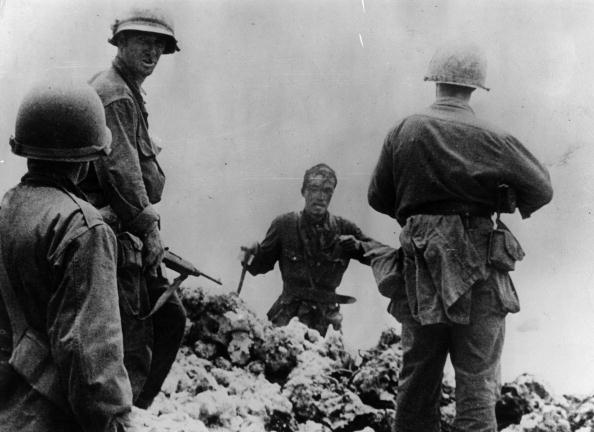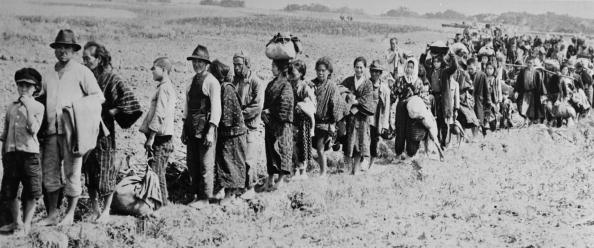Would the Japanese have surrendered without Hiroshima? For decades the question has lingered, as historians have challenged one of the most important American rationales for dropping the bomb. While we can never know what the Japanese would have done in other circumstances, the question comes freshly into view in Descent into Hell: Civilian Memories of the Battle of Okinawa, a remarkable new book based on Japanese eyewitness testimony from one of the bloodiest land battles of the war.
Two things jump out about this big book. One is that it is unusual to read extensive personal accounts of civilians on the enemy side who suffered in large numbers during World War II. The second is that, at least to judge by the inhabitants of Okinawa, many Japanese civilians, together with their emperor, were unwilling to surrender.
The huge US offensive in Okinawa—the only part of Japan where US forces fought on the ground—lasted eighty-two days in the spring of 1945 and cost about as many lives altogether as the atom bombs themselves. The US invading force of 1,050 ships carrying 548,000 men vastly outnumbered the 110,000 Japanese soldiers defending the island. But the Japanese held out with remarkable tenacity, and 77,000 Japanese soldiers and over 140,000 civilians would be killed before the US could declare victory. On the US side, more than 14,000 troops lost their lives, including 4,900 sailors felled by Japanese kamikaze—“divine wind”—suicide pilots, of which there were 3,050. As Hanson W. Baldwin, the New York Times war correspondent, described it, “Never before had there been, probably never again will there be, such a vicious sprawling struggle.”
I was thirteen at the time and recall my feelings of pride that American soldiers were yet again beating the fiendish, barely human Japanese. This was bolstered by the press and by super-patriotic films like Wake Island, in which Americans lost but only temporarily. Later, after Hiroshima and Nagasaki, a new belief took hold among liberal and leftist Americans: that the reasons given for dropping the bombs—among them, above all, that the Japanese would never surrender unless pulverized—were self-serving and false. Because of this new book I am thinking again.
The survivors’ accounts contained in Descent into Hell were originally gathered in the early 1980s by the Okinawan newspaper Ryukyu Shimpo, in which reporters discovered that these civilian wartime memories had been repressed in postwar Japan. Nearly thirty years later, the translator and Okinawan specialist Mark Ealey, together with Alastair McLauchlan, secured permission from the newspaper to use these testimonies as the basis of a new, English-language account of the battle from the eyes of Japanese civilians. In assembling this nearly five-hundred-page book, the translators have incorporated the testimony into a chapter-by-chapter account of the battle that includes their own extensive commentary and analysis, as well as notes on specific themes, maps, and a timeline of the battle itself. In an introductory essay, the former governor of Okinawa, Ota Masahide, writes that, “The Battle of Okinawa was distinct from all other battles in the Pacific War in that it was fought…with the majority of the resident civilian population still present.” According to Ota, “The horrific death toll and the fanatical resistance by the Japanese soldiers affected the thinking of the American leaders and was a significant factor leading to the decision to drop atomic bombs on mainland Japan.”
Out of a population on the island of 450,000, one third were killed and many more wounded. Many of those killed were young teenagers, totally untrained but keen to scout, carry ammunition, and to nurse. Others died in caves where they had sought refuge. Entire families were wiped out—whether by American shelling and bombing, by committing suicide, or by Japanese soldiers who feared they might surrender or were spies. The testimonies of those young people and their parents are detailed, unrancorous, and poignant.
“We wanted to be of use to the country as quickly as we could,” the sole survivor of a signal corps unit made up of teenage boys recalls. “We were consumed by a burning desire to offer our lives in defense of the nation. We had no fear of death whatsoever.” Another who was a boy at the time similarly describes the so-called “infiltration raids” in which he and his friends were sent to disrupt enemy lines: “Classmates dropped in front of my eyes, one after the other, launching those raids where death was the only possible outcome. They went on those raids simply to get killed. That’s how war is.” Some felt regret about their own survival. “I was envious of my school friends who died,” one Okinawan recalls. “I thought that it was just a matter of time before my number was up too….I really thought that it would be easier to die sooner than later.”
Advertisement
Another student remembers how those already sent to fight would write letters to friends saying they would “meet at the Yasukuni Shrine” on the mainland where people who died for the emperor were commemorated. “We always felt that, however grim things seemed, there was no way that our divine nation would lose the war….That’s because we were all more than happy to die for our country.”
In some ways, the experience of the war seems to have been even more traumatic for young girls, who were enlisted as nurses to care for the wounded or even to deal with dead bodies in the most horrific circumstances. Many were given hand grenades by the military or phials of potassium cyanide by medical staff so they could take their own lives rather than risk capture. One, who dealt with the dead, says, “There were so many bodies out there that we weren’t able to carry out a proper burial. There were blowflies all over the swollen, bluish-black corpses. They no longer looked like human beings. But the thing that frightened me most was myself. It was as though I’d become some sort of hard-hearted person who couldn’t cry even when I saw a dead body. I felt that I’d turned into a cold human being.”
All we hoped for, one schoolgirl nurse says, was to “die in an appropriate manner.” Another recalls how ten of her classmates who were about to be captured by the Americans decided to commit group suicide with their teacher. “When I went over to look, I could see Mr. Taira lying on the ground surrounded by the girls, all lying limp and inert around him. Pieces of flesh were all around. The face of one of the third year students was just covered in blood. I remember that I was so shocked that it didn’t seem to register.”
So pervasive was the cult of self-sacrifice that several women say they had to be reminded that survival was important too: “Death is not the only way to serve your country,” one unit commander told the schoolgirl nurses under his watch. “I’ve got children your age and think of all of you as my children, so I can’t lead you to your deaths. You have been through an experience that children from other prefectures could not even begin to imagine.”
Throughout the terrific shelling and bombing of the island and gassing of the caves where civilians had taken refuge, the Americans called loudly on the Japanese to surrender. It was apparent from the outset that the US forces were overwhelmingly superior; survivors recall that enemy pilots’ faces could be seen. Paradoxically, for those that did get captured, the dreaded Americans seem to have taken care of their prisoners—military and civilian—relatively well. “I hated and feared those Americans,” one survivor recalls, “but they treated me with great care and kindness, while my classmates, my teachers, left me behind.”
Bolstered by Ealey and McLauchlan’s extensive research, Descent into Hell records that from the late nineteenth century, Japanese education became highly nationalistic and militarized. On Okinawa, students were commanded to show total devotion to the emperor and therefore to the nation, and during the war most Okinawans obeyed military orders as though they had been given by the emperor himself. Any form of coercive message from the Imperial Japanese Army, the translators write, was manifested in a determination to die rather than surrender—a determination heightened by what the soldiers told Okinawans, especially children: that the Americans would commit terrible depredations on anyone who fell into their hands. (The book suggests that Japanese soldiers were re-telling actual atrocities they had committed in China.) This explains why many civilians killed themselves after killing helpless but acquiescent members of their families. Such tale-telling by the military to encourage suicide was embarrassing enough years later for it to be edited substantially from history textbooks.
The result for Okinawa—and Japan—was cataclysmic. In early 1945, the Japanese prime minister had recommended that the war be brought to an end, but as Ealey and McLauchlin write, Hirohito believed that one last military success “would force the United States and its allies to offer peace terms that would allow Japan to maintain its national polity, which of course hinged on the status and institution of the emperor.“ Had the prime minister’s advice been followed, they observe, “there may never have been a Battle of Okinawa, or atomic bombs dropped on Hiroshima or Nagasaki.” Indeed. General Douglas MacArthur urged that the emperor’s status be preserved, and there is a memorable photograph of the two recent adversaries standing side by side in Tokyo not long after the war ended. Hirohito’s descendants have remained on the throne to this day. What we learn from this profoundly disturbing and enlightening book is that tens of thousands of misled Okinawans died for nothing.
Advertisement
Descent into Hell: Civilian Memories of the Battle of Okinawa, translated by Mark Ealey and Alastair McLauchlan, has just been published by Merwin Asia and is distributed by University of Hawaii Press.




